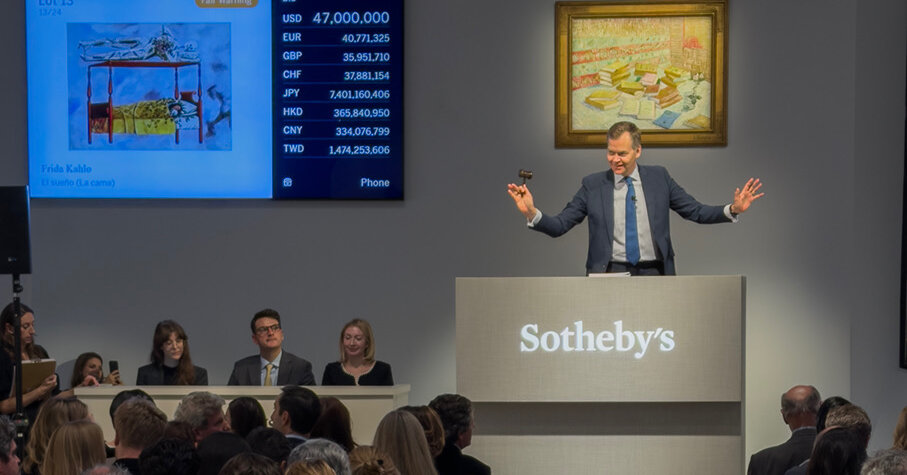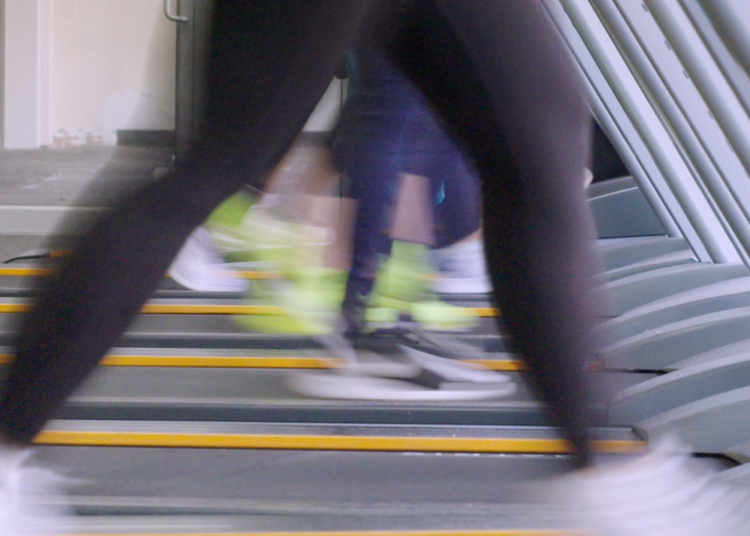Auction houses deal in superlatives to convince their ultrawealthy clients that art is worth millions of dollars. A Basquiat painting must open “a window onto another world.” A Rothko canvas must achieve “an intensity that resonates with the human condition.” And a sculpture by Jean Arp must have “presence evoking both the corporeal and transcendental.”
Over the last three years, collectors may have become disillusioned with such hyperbole. There were layoffs at auction houses. Major galleries closed. Sales continued to shrink, by 12 percent last year, according to the recent survey of global collecting by Art Basel and UBS.
But with some business strategy and a little luck, auction houses sold $2.2 billion worth of art last week. Altogether, the November marquee auctions in New York generated a 77 percent increase over last year’s equivalent sales (though still down 30 percent from the market’s recent peak of $3.2 billion in 2022).
How did they do it? This year, the auction houses reined in their estimates and encouraged sellers to lower their expectations. They also guaranteed that 70 percent of the evening sales’ estimated value was as good as sold before the salesroom doors opened.
Executives sourced rare paintings from the estates of the recently deceased, including the philanthropist Leonard A. Lauder, whose Gustav Klimt portrait generated $236.4 million, the second most expensive work of art ever sold at auction. And collectors were able to stretch their budgets thanks to a booming stock market.
“Everyone feels a sense of excitement and relief that there is real life in the art market,” said Robert Goff, a deputy chairman at the art advisory Gurr Johns.
Beyond spectacles like Maurizio Cattelan’s $12.1 million gold toilet — bought by the entertainment company Ripley’s Believe It or Not — and a $5.4 million triceratops fossil, bidding was robust for objects as wide ranging as a coffee table by Diego Giacometti ($4.5 million), expressive bronze figures by Henri Matisse ($16.7 million apiece) and a forest scene by the contemporary artist Yu Nishimura ($711,200, almost six times expectations).
Still, works with aggressive estimates, or lesser examples of artists’ work, failed to find buyers, including a painting of a woman sitting next to a Coke machine by Barkley L. Hendricks (high estimate: $12 million) and a muddy-colored abstract work by Cecily Brown (high estimate: $6 million).
The mixed results signaled that if the art market has not returned to its recent heights, it has perhaps found its footing. Twelve paintings sold for more than $20 million each, up from seven last November, but down from 24 in November 2023.
“Do I think all of a sudden every artwork at a mediocre gallery is going to sell? No, and I don’t think the market is healthy when it’s bananas-over-the-top,” said the art adviser Meredith Darrow. “I think we are entering into a healthier version of the market.”
As the dust settles, here are six trends from this season that point to where the art market is going.
A Quest for New Buyers
Last week’s sales seem to have benefited most from existing buyers returning to the market with new vigor.
Some were veteran collectors expanding their focus to fresh categories, such as Surrealism and 20th-century design, according to experts. Newer buyers are graduating to higher price points after receiving large inheritances as part of the multitrillion-dollar transfer of wealth between baby boomers and their offspring.
Stephanie Armstrong, a managing partner at the advisory firm Beaumont Nathan, said that Modernism’s appeal was “very much across generations,” with the firm’s clients in their 40s drawn to the aesthetic of artists such as Fernand Léger and Wassily Kandinsky. “We’re seeing this embrace of eclecticism and maximalism,” she added.
While the major auction houses were not immediately able to provide data about how many bidders and buyers this season were under the age of 45 — something that the industry has celebrated in previous years — their outreach to young buyers has included brand partnerships, a push into luxury sales, more emphasis on social media and even an alliance with art fairs outside the auction cycle, as Sotheby’s will strike in 2026 by hosting Independent 20th Century at the Breuer building in Manhattan.
Sotheby’s noted that 30 percent of the amount bid in its sales last week came from Asia (excluding the Middle East), about double the equivalent percentage in November 2024. This marks a welcome return from a region that had dialed back its art spending during the downturn. However, the house declined to specify where on the continent its buyers lived. Chinese buyers have largely withdrawn in recent years, according to market veterans.
Women on the Rise?
Sotheby’s sale of a record-breaking, $54.7 million Frida Kahlo self-portrait resurfaced a perennial question in the auction market: How long will it take for the prices for women artists to catch up with those of men?
There are signs of upward movement, including records set last week for Dorothea Tanning ($3.2 million), Lynne Drexler ($2 million), and Joan Brown ($596,900). The art adviser and former auction executive Saara Pritchard notes that even higher prices have been paid for Drexler and Kahlo in private transactions. Christie’s privately sold Frida Kahlo’s 1941 self-portrait “Me and My Parrots” in 2021 for more than $100 million, according to a source close to the deal.
But the public price gap between historical female artists and their male counterparts remains persistent for several reasons. First, women were often less prolific because they “did not have the support of the market to sustain that level of productivity,” Prichard said. And in contrast to traditional rules of supply and demand, in the art world, “when the market is starved a little bit, demand can die off.” Plus, Pritchard notes, wealthy collectors have spent decades seeing the work of white male artists celebrated in museums, while many institutions only began focusing on their female peers in the past 10 years.
Women artists comprised just under 15 percent of the works on offer during the marquee evening auctions last week. A collector could have bought all of them for $207 million — and still spent $29 million less than it cost to buy the record-setting Klimt portrait.
All That Glitters
In recent years, auction houses have adopted Hollywood stunt casting, drawing new clients with spectacles like a red Ferrari or a shredded Banksy. This week, it meant stocking up on gold, with mixed results.
Maurizio Cattelan’s “America” (2016), a functional toilet made from 100 kilograms of 18-karat gold, sold to Ripley’s Believe It or Not on a single bid of $12.1 million. The price was equivalent to the cost of raw materials plus the auction house’s fees. Phillips offered a gold nugget called “The Thunderbolt” — marketed as “nature’s masterpiece” with a $1.5 million high estimate — that failed to sell.
There was considerably greater competition for more traditional artworks with gold elements. A fantastical image of a man riding a snail with gold leaf by the artist Noah Davis, who died in 2015, sold for $1.4 million at Christie’s, well over its $1 million high estimate. A shimmering sculptural tapestry laced with gold leaf by Olga de Amaral sold for $3.1 million, more than five times its high estimate and a record for the 93-year-old Colombian fiber artist.
Darrow, the art adviser, said the week’s results indicated that “real art lovers, not speculators or Bitcoin bros” are driving the market’s recovery.
Surrealism Surges
Sotheby’s sold more than $128 million in Surrealist art last week, its highest total for the genre in a single week. The majority of that amount was spent in its single-owner “Exquisite Corpus” evening sale, led by Kahlo’s self-portrait.
Competition among bidders also resulted in new auction highs for once-secondary figures like Tanning, Wolfgang Paalen and Hans Bellmer. The strong sales reflect a demand for Surrealism that has broadened over the last 15 years, according to experts.
“Surrealism has for a long time been the prerogative of the London sales,” said Emmanuel Di Donna, whose Manhattan gallery focuses on Surrealist, Modernist, and postwar art. Now, “you have buyers globally for Surrealism, especially at the top.”
Wendi Norris, a gallerist who champions the movement, recognized bidders from across the world during the “Exquisite Corpus” sale, adding that “women with more disposable income, interest and attention have been coming into the marketplace in a big way.”
She traces the current surge to 2012, when the Los Angeles County Museum of Art staged an exhibition of female Surrealists from the U.S. and Mexico and the Museum of Modern Art started acquiring a wider range of Surrealist art.
“When they started buying, then everyone else came in,” Norris said.
Ultracontemporary: The Herd Thins
Nowhere was the market’s reset more obvious than for sales of work by “ultracontemporary” artists, meaning those born in 1975 or later.
In November 2024, Christie’s, Sotheby’s and Phillips featured 16 ultracontemporary artists in their marquee New York evening auctions. Last week they offered nine: Nishimura, Robert Alice, Lucy Bull, Firelei Báez, Noah Davis, Jadé Fadojutimi, Adrian Ghenie, Antonio Obá and Matthew Wong.
The results were uneven.
New auction records were set for Nishimura, Alice, Davis, Obá and Báez, whose painting of tropical feathers overlaying a colonial map at Christie’s quintupled its high estimate, selling for $1.1 million. But bidding for a monumental Fadojutimi painting at Phillips stalled at $500,000 — well below its $800,000 low estimate — and a Bull work later in the same auction sold for $490,000. Both artists have seen at least 10 of their paintings sell for more than $1 million since 2022, according to the Artnet Price Database.
Benjamin Godsill, a New York-based adviser, said that “collectors looking to resell quickly have been washed-out of the system” by the past three years of turbulence. This has given auction house specialists the leverage to decline works by ultracontemporary artists unproven at auction.
The Whims of the Market, Revealed
In the unpredictable and emotional auction market, the thrill of competition can lead someone to overpay. “It’s not a linear market,” Darrow said. The week offered plenty of examples of both price depreciation and appreciation. Taking into account inflation, here are three examples of falling values in repeat sales:
-
A painting by Emily Mae Smith of a cartoonish figure and a grape tree that sold for $454,000 in 2022 fetched $63,500 at Christie’s on Thursday, a drop in value of 88 percent.
-
An 1835 painting of the fortress of Ehrenbreitstein by J.M.W. Turner that sold for $23.9 million at Sotheby’s in 2017 decreased in value by 62 percent, selling for $11.9 million at Christie’s on Monday.
-
A 1965 collage of feet on the beach by Tom Wesselmann that sold for $53,846 at Christie’s in 2015 decreased in value by 52 percent, bringing in $35,560 at Sotheby’s on Wednesday.
There were also plenty of instances of prices rising based on sustained demand for an artist’s work, such as:
-
Joan Mitchell’s 1969 “Sunflower V,” an Abstract Expressionist work that sold for $1.5 million at Christie’s in 2005 increased in value by 578 percent at Christie’s on Monday, selling for $16.7 million.
-
“High Society,” an eight-foot-long Cecily Brown composition from 1997-98 that sold for $968,000 at Sotheby’s in 2006 appreciated by 530 percent, fetching $9.8 million at Sotheby’s on Tuesday.
The market may be choosy, said the art adviser David Norman, but “you can’t keep a good picture down.”
Zachary Small is a Times reporter writing about the art world’s relationship to money, politics and technology.
The post In a $2.2 Billion Week, the Art Market Finds Its Footing appeared first on New York Times.




